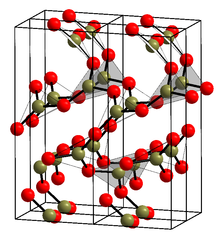
Back ثلاثي أكسيد البورون Arabic Bor oksidi Azerbaijani بور تریاوکسید AZB Oxid boritý Czech Bortrioxid German Óxido de boro Spanish بور تریاکسید Persian Booritrioksidi Finnish Sesquioxyde de bore French बोरॉन ट्राईऑक्साइड Hindi
![Crystal structure of B2O3 [1]](http://upload.wikimedia.org/wikipedia/commons/thumb/d/d9/B2O3powder.JPG/220px-B2O3powder.JPG) | |
 | |
| Names | |
|---|---|
| IUPAC name
Diboron trioxide
| |
| Other names
boron oxide, diboron trioxide, boron sesquioxide, boric oxide, boria
Boric anhydride | |
| Identifiers | |
3D model (JSmol)
|
|
| ChEBI | |
| ChemSpider | |
| ECHA InfoCard | 100.013.751 |
| EC Number |
|
| 11108 | |
PubChem CID
|
|
| RTECS number |
|
| UNII | |
CompTox Dashboard (EPA)
|
|
| |
| |
| Properties | |
| B2O3 | |
| Molar mass | 69.6182 g/mol |
| Appearance | white, glassy solid |
| Density | 2.460 g/cm3, liquid; 2.55 g/cm3, trigonal; |
| Melting point | 450 °C (842 °F; 723 K) (trigonal) 510 °C (tetrahedral) |
| Boiling point | 1,860 °C (3,380 °F; 2,130 K) ,[2] sublimes at 1500 °C[3] |
| 1.1 g/100mL (10 °C) 3.3 g/100mL (20 °C) 15.7 g/100mL (100 °C) | |
| Solubility | partially soluble in methanol |
| Acidity (pKa) | ~ 4 |
| −39.0·10−6 cm3/mol | |
| Thermochemistry | |
Heat capacity (C)
|
66.9 J/(mol⋅K) |
Std molar
entropy (S⦵298) |
80.8 J/(mol⋅K) |
Std enthalpy of
formation (ΔfH⦵298) |
−1254 kJ/mol |
Gibbs free energy (ΔfG⦵)
|
−832 kJ/mol |
| Hazards | |
| Occupational safety and health (OHS/OSH): | |
Main hazards
|
Irritant[4] |
| GHS labelling: | |

| |
| Danger | |
| H360FD | |
| P201, P202, P281, P308+P313, P405, P501 | |
| NFPA 704 (fire diamond) | |
| Flash point | noncombustible |
| Lethal dose or concentration (LD, LC): | |
LD50 (median dose)
|
3163 mg/kg (oral, mouse)[5] |
| NIOSH (US health exposure limits): | |
PEL (Permissible)
|
TWA 15 mg/m3[4] |
REL (Recommended)
|
TWA 10 mg/m3[4] |
IDLH (Immediate danger)
|
2000 mg/m3[4] |
| Supplementary data page | |
| Boron trioxide (data page) | |
Except where otherwise noted, data are given for materials in their standard state (at 25 °C [77 °F], 100 kPa).
| |
Boron trioxide or diboron trioxide is the oxide of boron with the formula B2O3. It is a colorless transparent solid, almost always glassy (amorphous), which can be crystallized only with great difficulty. It is also called boric oxide[6] or boria.[7] It has many important industrial applications, chiefly in ceramics as a flux for glazes and enamels and in the production of glasses.
- ^ Cite error: The named reference
a1was invoked but never defined (see the help page). - ^ High temperature corrosion and materials chemistry: proceedings of the Per Kofstad Memorial Symposium. Proceedings of the Electrochemical Society. The Electrochemical Society. 2000. p. 496. ISBN 978-1-56677-261-7.
- ^ Cite error: The named reference
patnaikwas invoked but never defined (see the help page). - ^ a b c d Cite error: The named reference
PGCHwas invoked but never defined (see the help page). - ^ "Boron oxide". Immediately Dangerous to Life or Health Concentrations (IDLH). National Institute for Occupational Safety and Health (NIOSH).
- ^ Cite error: The named reference
mccu1937was invoked but never defined (see the help page). - ^ Cite error: The named reference
vish2015was invoked but never defined (see the help page).
